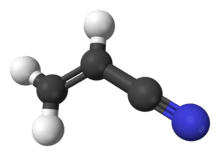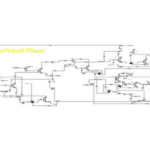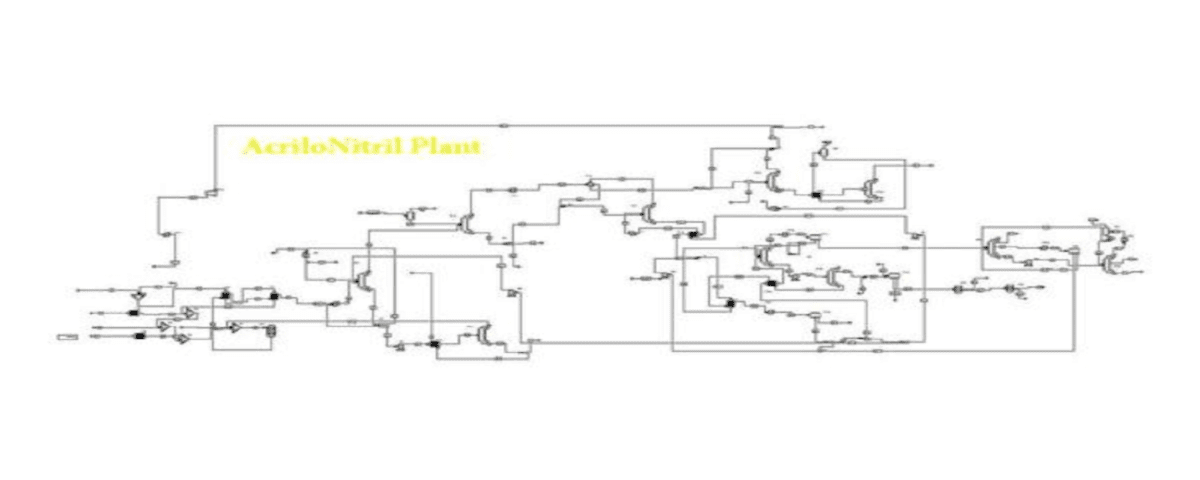Acrylonitrile
Acrylonitrile is an organic chemical compound with the chemical formula CH₂=CHCN. This compound is a volatile, colorless liquid with a distinct odor; however, commercial grades may contain impurities that can give it a yellowish tint. The acrylonitrile molecule consists of a vinyl group attached to a nitrile group, making it a critical monomer for the production of various plastics and other industrial materials. Due to its reactivity and toxicity, especially in higher concentrations, handling and storage of acrylonitrile require strict safety measures.

Acrylonitrile Production
Acrylonitrile is commercially produced primarily via the ammoxidation of propylene. In this process, propylene, ammonia, and oxygen react in the presence of a specific catalyst within a fluid bed reactor to form acrylonitrile. The production process includes the following stages:
- Propylene Ammoxidation Reaction: Propylene and ammonia react at high temperatures with oxygen in a controlled environment with a catalyst.
- Purification: The produced acrylonitrile undergoes a purification process to remove any impurities.
- Recovery and Storage: The purified acrylonitrile is stored and prepared for various industrial applications.
Applications of Acrylonitrile
Acrylonitrile is a valuable precursor and intermediate chemical used in the production of numerous industrial and commercial products, including:
- Plastics and Acrylic Fibers: Acrylonitrile is essential in producing durable and resistant polymers such as polyacrylonitrile, widely used in textile and synthetic fiber industries.
- Modacrylic Fibers: These fibers, produced from acrylonitrile, are used in flame-retardant and heat-resistant clothing.
- Nitrile Resins and Elastomers: Acrylonitrile-based polymers are highly resistant to wear and chemicals, making them vital in automotive and medical industries.
- Chemical Intermediates: Acrylonitrile serves as a base material in producing antioxidants, dyes, pharmaceuticals, and adhesives.
Safety and Environmental Considerations
Due to its toxicity and high reactivity, acrylonitrile must be handled with care. Direct exposure and inhalation can pose significant health risks. Previously, acrylonitrile was used as a disinfectant in processes such as grain milling and baking. However, its usage in such applications has decreased due to environmental and toxicity concerns.
Simulation of the Acrylonitrile Production Process Using Aspen Plus
In this project, the acrylonitrile production process from ethylene was simulated using Aspen Plus V10 software, based on data from the SRI petrochemical library. Aspen Plus is a highly-regarded software tool for modeling and simulating chemical processes, enabling engineers to design complex systems, optimize processes, and analyze performance efficiently. This software has been utilized in this project to accurately simulate each production stage, assess operational conditions, and evaluate overall process efficiency.
Stages of Acrylonitrile Production Process Simulation
- Defining Raw Materials and Products: The simulation begins by specifying the raw materials and products involved, such as ethylene, ammonia, oxygen, and acrylonitrile. These materials, along with their physical and chemical properties, including boiling points, freezing points, and reaction coefficients, are defined in the software.
- Reaction Definition and Process Kinetics: The next step involves defining the chemical reactions in the process, such as the ammoxidation of ethylene. These reactions occur at high temperatures in the presence of a catalyst. In this simulation, the reaction mechanism and kinetics, including reaction rates, are modeled to achieve high accuracy.
- Process Equipment Design: Key equipment, such as reactors, distillation columns, and purification units used in acrylonitrile production, is meticulously modeled in the simulation. Aspen Plus provides tools for designing various equipment types and specifying dimensions, flow rates, and other operational parameters, which are utilized in this project.
- Operational Condition Analysis: One of the most critical stages in simulation is optimizing operational conditions. Factors such as temperature, pressure, and reactant ratios are carefully adjusted to maximize yield and minimize waste. This stage helps engineers determine optimal conditions to achieve maximum production efficiency with minimal energy consumption.
- Simulation of Purification and Recovery Stages: After initial acrylonitrile production, purification and impurity separation stages are simulated using distillation and other separation methods. This phase improves the quality of the final product and reduces unwanted components in acrylonitrile.
- Process Stability Analysis and Evaluation: In the final stage, simulation results are reviewed to assess economic and sustainable viability. This analysis includes energy consumption, waste generation, and performance comparisons under varying conditions.
Benefits of Acrylonitrile Production Process Simulation
- Cost Reduction: Simulating the acrylonitrile production process with Aspen Plus allows for detailed analysis and optimization without the need for costly and time-consuming experimental trials.
- Enhanced Safety: By simulating different scenarios, critical process points can be identified, ensuring a safer implementation in real-world conditions.
- Reduced Environmental Impact: Simulation enables the identification and optimization of factors contributing to lower emissions and energy usage.
- Improved Efficiency: Optimizing operational conditions and equipment increases the process’s overall efficiency, enabling the production of the final product at the lowest possible cost.
The Importance of Simulation in the Petrochemical Industry
Process simulations are crucial in the petrochemical industry. Software like Aspen Plus provides engineers with detailed tools for accurately modeling and assessing complex chemical processes. In this project, simulating the acrylonitrile production process from ethylene has empowered engineers to optimize design, reduce costs, and predict outcomes prior to actual process implementation.
Conclusion
Simulating the acrylonitrile production process from ethylene using Aspen Plus is a powerful method for analyzing and optimizing chemical processes.
Simulation of Acrylonitrile Production Process from Ethylene


